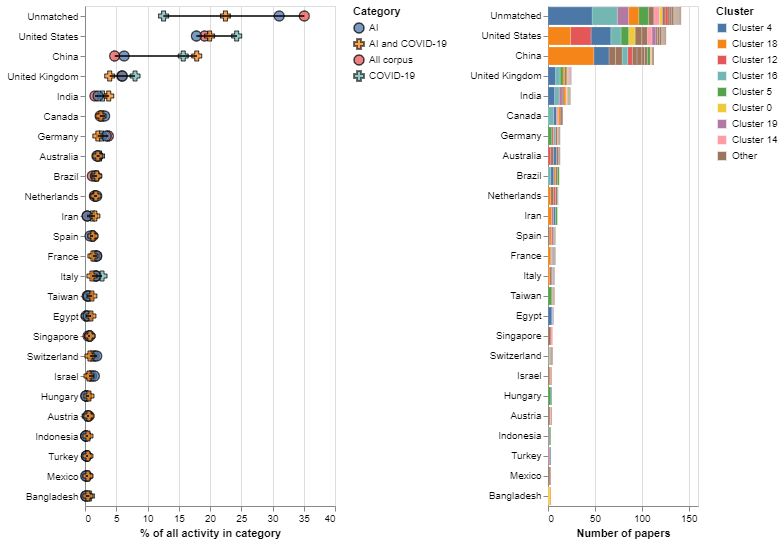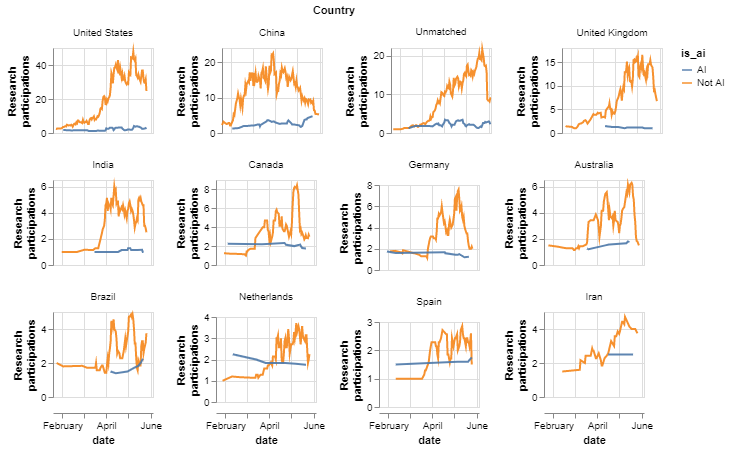We have matched the institutional affiliations of the papers in our corpus with the Global Research Identifier (GRID) in order to analyse the geography of artificial intelligence (AI) research to tackle COVID-19.
The left point chart of Figure 6 shows the share of all activity in our corpus, AI research in general and AI research to tackle COVID-19 accounted for by the top 25 countries by size in the corpus.
First, we note that in a significant number of cases we are not able to match the institution involved in a paper with GRID – we label these cases as ‘unmatched’. Interestingly, matching rates are much higher for COVID-19 research in general than for AI research and COVID-19 oriented AI research, where we are unable to match institutions with GRID in almost 20 per cent of the cases. One interpretation for this is that COVID-19 research, in general, involves more and better known academic institutions likely to be captured by GRID, while the latter involves other actors, potentially new entrants in the research ecosystem who perhaps benefit from lower barriers to entry due to widespread availability of data and algorithms. Understanding who these institutions are and the factors driving their participation in research to tackle COVID-19 is an important question for future research.
Figure 6: The US and China dominate AI applications to tackle COVID-19, and we identify many new (unmatched) actors active in the field

An interactive version of this graph is available in the online report
Focusing on those institutions that we have been able to match with GRID, we find that the five most active countries in the deployment of AI to tackle COVID-19 are the US and China, which together account for more than 40 per cent of research in this area.[3] They are followed by the UK, India, Canada and Germany – all countries that rank highly in most AI research maps (Klinger et al., 2018).
China’s share of COVID-19 and COVID-19 oriented AI activity is higher than we would expect, given its overall presence in the data, which suggests a strong focus on these subjects in that country.
Leaving out unmatched institutions, we find that 62 per cent of all AI research to tackle COVID-19 concentrates in the top five countries, which is similar to the concentration of COVID-19 research, and 12 per cent higher than the share of all activity in our corpus accounted for by the top five countries.
The right bar in Figure 6 presents the number of research participations in papers in different topical clusters by country, also including unmatched institutions. We see clear international differences in the topical focus of AI research to tackle COVID-19. For example:
- Unmatched institutions primarily focus on computer vision with medical scans (cluster 14) and analyses of social media data (cluster 16) – these are AI applications with relatively low ‘barriers to entry’.
- The United States and China are more focused on the topical cluster of computer vision that involves medical scientists (cluster 18).
- We also detect higher levels of AI biomedical activity (cluster 12) and analyses of the transmission of COVID-19 (cluster 0) in the US.
Figure 7 presents the evolution of participations in COVID-19 research from institutions in different countries. We see some evidence that COVID-19 related research tracks awareness of the disease in a country: China was the first country to reach more than 25 per cent of its COVID-19 related research activity (in early March 2020), followed by Iran three weeks later, and Canada and the US a month later. European countries and the UK have been somewhat slower in reaching that threshold, if only by a few days.
Figure 7: Evolution of activity in different countries

An interactive version of this graph is available in the online report
Footnotes
3. By participation, we mean participation of an institution from a country in a paper.






